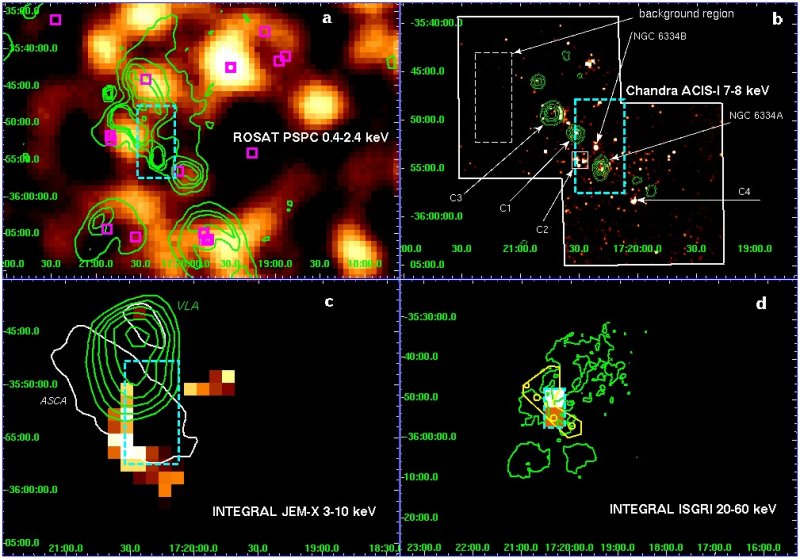INTEGRAL
detection of hard X-rays from NGC 6334
In the crowded field of the NGC 6334 star-forming region a hard emission source
has been detected with
INTEGRAL.
Do the colliding winds of young massive stars accelerate electrons to produce hard X-rays
or is it just a powerful AGN hidden in a cloud?
What follows is just a brief summary, but see the regular paper
accepted by Astronomy and Astrophysics
or in the arXiv (astro/ph 0512627)
for a complete version.
We report the detection of hard X-ray emission from the field of
the star-forming region NGC 6334 with the the International Gamma-Ray
Astrophysics Laboratory INTEGRAL
. The JEM-X
monitor and
ISGRI imager aboard INTEGRAL
and Chandra
ACIS
imager were used to construct 3-80 keV images and
spectra of NGC 6334.
The 3-10 keV and 10-35 keV images made with
JEM-X
show a complex structure of extended emission from NGC 6334. The
ISGRI source detected in the energy ranges 20-40 keV, 40-80 keV, and 20-60 keV
coincides with the NGC 6334 ridge. The 20-60 keV flux from the source
is (1.7±0.37)×10-11
erg cm-2 s-1. Spectral analysis of the
source revealed a hard power-law component with a photon index
about 1. The observed X-ray fluxes are in agreement with
extrapolations of X-ray imaging observations of NGC 6334 by
Chandra
ACIS
and ASCA GIS .
The X-ray data are consistent with two very different physical
models. A probable scenario is emission from a heavily absorbed,
compact and hard Chandra
source that is associated with the AGN candidate radio source NGC 6334B.
Another possible model is the extended Chandra
source of nonthermal emission from NGC 6334 that
can also account for the hard X-ray emission observed by
INTEGRAL.
The origin of the emission in this scenario is due to
electron acceleration in energetic outflows from massive early
type stars. The possibility of emission from a young supernova
remnant, as suggested by earlier infrared observations of NGC 6334,
is constrained by the non-detection of 44Ti lines.

a)
ROSAT
RASS
0.4-2.4 keV map with
MOST MGPS 843 MHz contours. Massive stars, visible in the optical
band are shown by boxcircles (O stars) and boxes (B stars).
b) Chandra
7-8 keV map smoothed with a 2 pixel Gaussian kernel
and VLA NVSS 1.4 GHz contours.
The background region used for Chandra
analysis is marked as well as the main
sources of Chandra emission within the
ISGRI excess.
c) JEM-X 3-10 keV map with
ASCA GIS
6-10 keV contours
and VLA GPS 8.35 GHz contours.
d)
ISGRI 20-60 keV map with
DSS-R contours. The P-shaped
region with circles indicates the NGC 6334 ridge with starforming complexes as
seen in 71μm IR band by
Loughran et al. (1986). Bright
ISGRI pixels are shown on panels a) -- c) as dashed rectangles.


